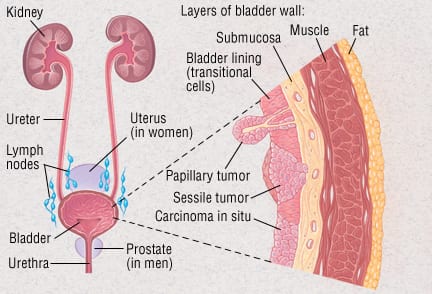Patient Basics: Bladder Cancer
Originally published by Harvard Health.
What Is It?
This type of cancer occurs in the bladder — the organ that stores urine. The bladder has an inner lining surrounded by a layer of muscle. Bladder cancer begins in the inner lining of the bladder. It is usually discovered before it has spread past this lining.
Risk factors for bladder cancer include:
- Cancer-causing substances such as tobacco smoke and chemicals in the environment
- Exposure to certain industrial chemicals
- Long-standing bladder stones
Bladder cancer tends to return in people who have had the disease.
Symptoms
Many people with bladder cancer have no symptoms. Instead, the diagnosis is made when red blood cells are detected in a urine sample. However, people with bladder cancer generally don’t see blood in their urine. There is not enough blood to change the urine color. This is called microscopic hematuria.
When symptoms of bladder cancer do occur, they include:
- Red or rust colored urine caused by the presence of many red blood cells (called macroscopic hematuria)
- Painful urination or burning when urinating
- More frequent urination than normal
Diagnosis
Your doctor will review your medical history. He or she will ask about any history of kidney stones or urinary tract infections. These conditions can also cause blood in the urine. Your doctor will ask about your occupation and your diet.
Your doctor will ask about your history of cigarette smoking. If you don’t smoke now, but did in the past, tell your doctor. Your risk of bladder cancer remains high for more than 10 years after your last cigarette.
After reviewing your symptoms and risk factors, your doctor will examine you. The exam will include a rectal examination. Women will also have a pelvic examination.
Your doctor will order laboratory tests. These will include urine and blood tests. The urine sample will be checked for the presence of red blood cells and to rule out an infection. The blood test is used primarily to make sure your kidneys are functioning normally. Your doctor may also send the urine sample to a special lab to look for cancer cells.
Cystoscopy
The main test when looking for bladder cancer is cystoscopy. Your doctor inserts a medical instrument (called a cystoscope) through your urethra into your bladder. Your urethra is the opening through which you urinate. Your doctor will look inside your bladder to see if there are tumors.
If there are areas of the bladder lining that appear abnormal, your doctor will take one or more biopsies through the cystoscope. This involves cutting out a small piece of tissue. It can then be examined under a microscope to look for cancer cells. If possible, your doctor will remove the entire tumor during cystoscopy.
Additional tests may be needed to determine if the cancer has spread.
Expected Duration
Bladder cancer will continue to grow and possibly spread until it is treated.
Prevention
To reduce your risk of bladder cancer, don’t smoke. If you already smoke, ask your doctor about ways to help you quit.
People who drink plenty of water every day may have a lower risk of bladder cancer.
Some jobs increase exposure to chemicals that can cause bladder cancer. If you work with chemicals, find out what you can do to reduce your exposure.
Treatment
Treatment of bladder cancer depends on:
- How aggressive the cancer is
- If it has spread beyond the lining of the bladder
- How much it has spread
Tumor grade. The tumor grade is an estimate of how likely the cancer is to grow and spread rapidly.
- High grade bladder cancer is likely to grow and spread quickly and become life threatening. High-grade cancers often need to be treated with chemotherapy, radiation or surgery.
- Low-grade cancers appear non-aggressive and have a low chance of becoming high grade. They are rarely life threatening. Low-grade tumors tend to come back and need to be removed repeatedly. Still, aggressive treatments, such as radiation or bladder removal, are not usually needed.
Tumor stage
The stage is determined by whether:
- The tumor involves only the bladder lining
- The tumor has invaded the bladder muscle, tissues around the bladder or nearby organs
- The cancer has spread to nearby lymph nodes
- The cancer has spread to distant sites in other areas of the body
Treatment options vary depending on the stage.
Superficial tumors
Superficial tumors are cancers that involve only the bladder lining. These tumors are usually low-grade.
Superficial tumors are usually treated with a procedure called a transurethral resection. In this procedure, the doctor either removes the tumor or burns it away.
After transurethral resection, the doctor may place medications inside the bladder. This reduces the chance that the cancer will return. It may also prevent the cancer from progressing to a more advanced and dangerous stage.
High-grade superficial tumors that return more than once or twice after treatment are more serious. Many experts recommend that people with these types of tumors have surgery to remove the bladder. This is a major operation.
Carcinoma in situ
Carcinoma in situ is bladder cancer within only the most superficial lining of the bladder. Carcinoma in situ can be difficult to remove completely. Transurethral resection and medical therapy sometimes eliminate carcinoma in situ. If this fails, doctors usually recommend removing the bladder.
Radiation and chemotherapy are not effective against carcinoma in situ.
Tumors invading the bladder muscle
In this case, bladder cancer has grown into the muscle of the bladder wall. But it has not spread to the lymph nodes or distant organs.
The standard treatment is a surgery called radical cystectomy. Radical cystectomy removes the bladder, nearby lymph nodes and other nearby organs.
After removing the bladder, the surgeon must create a different way for the body to hold and pass urine. There are several options. Each procedure has advantages and disadvantages.
Some cancer doctors recommend chemotherapy before radical cystectomy. This is controversial. Cancer is less likely to return in some patients who receive chemotherapy before surgery. These patients may live longer. However, cancer doctors cannot predict which patients will get these benefits.
The other approach is to examine the bladder after surgery to see if a patient could benefit from chemotherapy. However, chemotherapy given after surgery may not be as effective as chemotherapy before surgery.
In some people who have very localized, less aggressive tumors, doctors may remove only the diseased part of the bladder.
Non-surgical approaches
One alternative to surgery is radiation therapy combined with chemotherapy. Only certain patients qualify for this approach. The advantage is the potential to keep your bladder. However, doctors don’t know whether it is as effective as surgery.
This approach should be considered if a patient is not a good candidate for surgery.
More extensive tumors
Radical cystectomy is usually used to remove bladder cancer that has invaded beyond the bladder wall. If the entire tumor cannot be removed, chemotherapy or radiation therapy can shrink the tumor. It may then be removed surgically.
Sometimes cancer invades through the bladder wall or spreads to lymph nodes. Chemotherapy after surgery may reduce the chance that this cancer will come back. However, bladder cancers that have spread to lymph nodes usually cannot be cured.
Metastatic bladder cancer
Bladder cancer that has spread to other organs or to distant lymph nodes is considered metastatic. Metastatic bladder cancer is usually fatal. Chemotherapy can help patients with metastatic bladder cancer live longer. A small number of patients may even be cured.
Important follow up
Patients who have had bladder cancer continue to have an increased risk of developing cancers in and around the bladder. Patients should be closely monitored for the rest of their lives.
When to Call a Doctor
Call your doctor immediately if:
- You notice blood in your urine
- Your urine turns the color of rust
- You begin to urinate more often than normal
- Urination is painful or uncomfortable
Prognosis
Your outlook depends on the stage of bladder cancer and the type of treatment used. Patients with superficial tumors have the best chance of survival. People with more invasive tumors or metastatic cancer generally have a poorer outlook.
Additional Information
National Cancer Institute (NCI)
U.S. National Institutes of Health
Public Inquiries Office
Building 31, Room 10A03
31 Center Drive, MSC 8322
Bethesda, MD 20892-2580
Phone: 301-435-3848
Toll-Free: 1-800-422-6237
TTY: 1-800-332-8615
http://www.nci.nih.gov/
American Cancer Society (ACS)
1599 Clifton Road, NE
Atlanta, GA 30329-4251
Toll-Free: 1-800-227-2345
http://www.cancer.org/
National Institute for Occupational Safety and Health
4676 Columbia Parkway
Mail Stop C-18
Cincinnati, OH 45226
Toll-Free: 1-800-356-4674
Fax: 513-533-8573
http://www.cdc.gov/niosh/








